
Algebraic notation is the standard method for recording and describing the moves in a game of chess. It is based on a system of coordinates to uniquely identify each square on the board. It is used by most books, magazines, and newspapers.
Descriptive notation is a chess notation system based on abbreviated natural language. Its distinctive features are that it refers to files by the piece that occupies the back rank square in the starting position and that it describes each square two ways depending on whether it is from White or Black's point of view. It was common in English, Spanish and French chess literature until about 1980. In most other languages, the more concise algebraic notation was in use. Since 1981, FIDE no longer recognizes descriptive notation for the purposes of dispute resolution, and algebraic notation is now the accepted international standard.
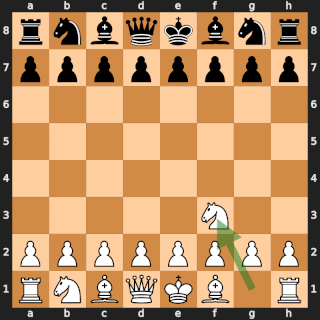
The Game of the Century is a chess game that was won by the 13-year-old future world champion Bobby Fischer against Donald Byrne in the Rosenwald Memorial Tournament at the Marshall Chess Club in New York City on October 17, 1956. In Chess Review, Hans Kmoch dubbed it "The Game of the Century" and wrote: "The following game, a stunning masterpiece of combination play performed by a boy of 13 against a formidable opponent, matches the finest on record in the history of chess prodigies."

Henry Ernest Atkins was a British chess master who is best known for his unparalleled record of winning the British Chess Championship nine times in eleven attempts. He won every year from 1905 to 1911, and again in 1924 and 1925. A schoolmaster, Atkins treated chess as a hobby, devoting relatively little time to it and playing in only a handful of international tournaments. He was an extremely gifted player who would likely have become one of the world's leading players had he pursued the game more single-mindedly. FIDE, the World Chess Federation, awarded him the International Master title in 1950 in recognition of his past achievements.
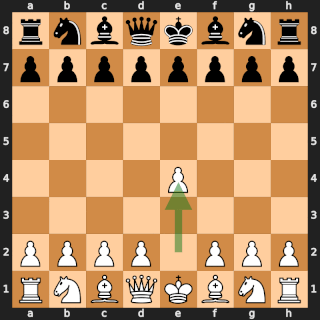
The Opera Game was an 1858 chess game, played at an opera house in Paris. The American master Paul Morphy played against two strong amateurs: the German noble Karl II, Duke of Brunswick, and the French aristocrat Comte Isouard de Vauvenargues. It was played as a consultation game, with Duke Karl and Count Isouard jointly deciding each move for the black pieces, while Morphy controlled the white pieces by himself. The game was played in a box while an opera was performed on stage. Morphy quickly checkmated his opponents following rapid development of material, involving a queen sacrifice.
The Pirc Defence is a chess opening characterised by the response of Black to 1.e4 with 1...d6 and 2...Nf6, followed by ...g6 and ...Bg7, while allowing White to establish a centre with pawns on d4 and e4. It is named after the Slovenian grandmaster Vasja Pirc.
The Nimzowitsch Defence is a somewhat uncommon chess opening characterised by the moves:
The Scotch Game, or Scotch Opening, is a chess opening that begins with the moves:
The Modern Benoni is a chess opening that begins with the moves 1.d4Nf6 2.c4c5 3.d5e6. It is classified under the ECO codes A60–A79. After the initial moves, Black proceeds to capture on d5, creating a majority of black pawns on the queenside. To support their advance, the king's bishop is usually fianchettoed on g7. These two features differentiate Black's setup from the other Benoni defences and the King's Indian Defence, although transpositions between these openings are common.
Rosendo Carreon Balinas Jr. was a chess grandmaster from the Philippines. FIDE awarded him the International Master title in 1975 and the International Grandmaster title in 1976. He was Philippines' second chess grandmaster. Balinas was a lawyer by profession, as well as an award winning chess writer and journalist. He also unsuccessfully ran for representative of Rizal's 1st district in the 1994 special election.
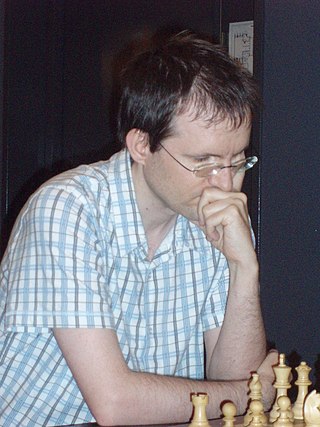
Rune Djurhuus is a Norwegian chess player, and the fourth Norwegian International Grandmaster. Djurhuus plays for the "Akademisk" chess club, which is tied to the University of Oslo. Djurhuus is also the chess columnist for Aftenposten and Adresseavisen.

Thomas Luther is a German chess player and International Grandmaster of chess. In 2000 he was a member of the German team that won the silver medal in the 34th Chess Olympiad in Istanbul.
The chess endgame of a queen versus pawn is usually an easy win for the side with the queen. However, if the pawn has advanced to its seventh rank it has possibilities of reaching a draw, and there are some drawn positions with the pawn on the sixth rank. This endgame arises most often from a race of pawns to promote.
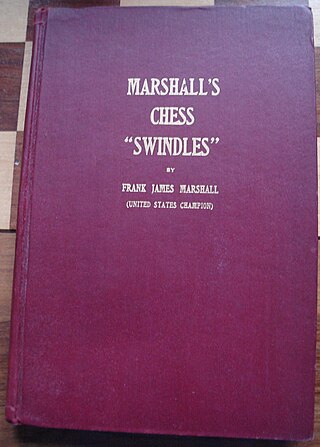
In chess, a swindle is a ruse by which a player in a losing position tricks their opponent and thereby achieves a win or draw instead of the expected loss. It may also refer more generally to obtaining a win or draw from a clearly losing position. I. A. Horowitz and Fred Reinfeld distinguish among "traps", "pitfalls", and "swindles". In their terminology, a "trap" refers to a situation where players go wrong through their own efforts. In a "pitfall", the beneficiary of the pitfall plays an active role, creating a situation where a plausible move by the opponent will turn out badly. A "swindle" is a pitfall adopted by a player who has a clearly lost game. Horowitz and Reinfeld observe that swindles, "though ignored in virtually all chess books", "play an enormously important role in over-the-board chess, and decide the fate of countless games".

Anatoly Yakovlevich Lein was a Soviet-born American chess player. He was awarded the title of Grandmaster by FIDE in 1968.
Edith Martha Holloway was a volunteer nurse in Serbia during World War I and a British chess player. She was the daughter of sculptor John Denton Crittenden (1834–1877), who exhibited at the Royal Academy.
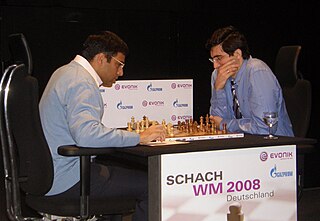
The World Chess Championship 2008 was a best-of-twelve-games match between the incumbent World Chess Champion, Viswanathan Anand, and the previous World Champion, Vladimir Kramnik. Kramnik had been granted a match after not winning the World Chess Championship 2007 tournament.
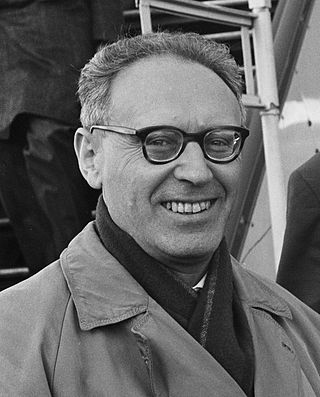
A World Chess Championship was played between Mikhail Botvinnik and Mikhail Tal in Moscow from March 15 to May 7, 1960. Botvinnik was the reigning champion, after winning the World Chess Championship 1958, while Tal qualified by winning the Candidates tournament. Tal won by a margin of 4 points.
The 14th season of the Top Chess Engine Championship took place between 17 November 2018 and 24 February 2019. Stockfish was the defending champion, having defeated Komodo in the previous season's superfinal.
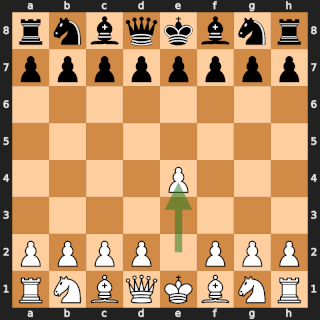
Kasparov's immortal is a chess game played by Garry Kasparov as White against Veselin Topalov as Black at the Hoogovens Wijk aan Zee Chess Tournament 1999 chess tournament. This is one of Kasparov's most famous games; it is considered a masterpiece and Chess.com has listed it as the No. 1 chess game ever played.











